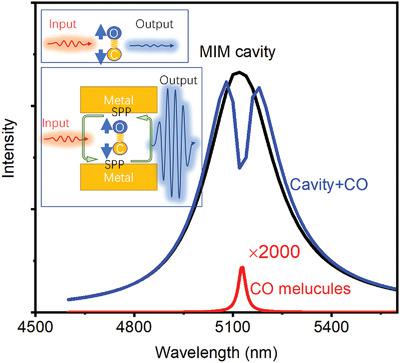当前位置:
X-MOL 学术
›
Adv. Theory Simul.
›
论文详情
Our official English website, www.x-mol.net, welcomes your
feedback! (Note: you will need to create a separate account there.)
Direct Detection of Ultraweak CO Signal with Cavity Plasmon by Resonant Vibration–Plasmon Coupling
Advanced Theory and Simulations ( IF 2.9 ) Pub Date : 2020-09-06 , DOI: 10.1002/adts.202000146 Da‐Jie Yang 1, 2
Advanced Theory and Simulations ( IF 2.9 ) Pub Date : 2020-09-06 , DOI: 10.1002/adts.202000146 Da‐Jie Yang 1, 2
Affiliation

|
Direct, instant, and quantitative detection of molecules is highly desirable, however, optical detection of dilute gas molecules in the single molecular limit is extremely challenging. According to a recent experiment, a thin CO molecule layer will be absorbed at the edge of a metallic nanoparticle when the particle is exposed to CO environment; therefore, optical sensor becomes possible with such a layer. Here, a prototype plasmonic sensor for direct CO molecules detection based on the vibrational coupling to the surface plasmon polariton resonance in a finite metal/insulator/metal (MIM) nanocavity is proposed and investigated. Thanks to the ultrahigh spectral sensitivity of the cavity plasmon and its enhanced coupling to the CO stretch vibration, the single‐layered molecules in the cavity split the plasmon resonance in its optical spectra. The molecular signal is amplified by up to three orders of magnitude, giving a detection limit of ≈800 molecules, which lowers down the detection limit of molecule numbers by more than three orders of magnitude than the traditional surface plasmon‐based sensors. In the investigation, analytical vibration/cavity–plasmon coupling model developed herein agrees well with the numerical results. The study offers a promising way toward small molecule detection with plasmonic sensors.
中文翻译:

共振共振-等离子体耦合直接检测带腔等离子体的超弱CO信号
分子的直接,即时和定量检测是非常需要的,但是,在单个分子范围内光学检测稀薄气体分子非常具有挑战性。根据最近的实验,当颗粒暴露在CO环境中时,薄的CO分子层将被吸收在金属纳米颗粒的边缘。因此,具有这样的层的光学传感器成为可能。在此,提出并研究了基于有限金属/绝缘体/金属(MIM)纳米腔中与表面等离子体激元共振的振动耦合的直接等离子体传感器的原型等离子体传感器。由于腔等离子体激元的超高光谱敏感性以及与CO拉伸振动的增强耦合,腔中的单层分子在其光谱中分裂了等离子体激元共振。分子信号最多可放大三个数量级,从而提供约800个分子的检测极限,这比传统的基于表面等离激元的传感器将分子数量的检测极限降低了三个数量级以上。在研究中,本文开发的分析振动/腔-等离子体耦合模型与数值结果非常吻合。这项研究为等离子体传感器检测小分子提供了一种有希望的方法。本文开发的解析振动/腔-等离子体耦合模型与数值结果吻合良好。这项研究为等离子体传感器检测小分子提供了一种有前途的方法。本文开发的解析振动/腔-等离子体耦合模型与数值结果吻合良好。这项研究为使用等离子传感器进行小分子检测提供了一种有前途的方法。
更新日期:2020-10-05
中文翻译:

共振共振-等离子体耦合直接检测带腔等离子体的超弱CO信号
分子的直接,即时和定量检测是非常需要的,但是,在单个分子范围内光学检测稀薄气体分子非常具有挑战性。根据最近的实验,当颗粒暴露在CO环境中时,薄的CO分子层将被吸收在金属纳米颗粒的边缘。因此,具有这样的层的光学传感器成为可能。在此,提出并研究了基于有限金属/绝缘体/金属(MIM)纳米腔中与表面等离子体激元共振的振动耦合的直接等离子体传感器的原型等离子体传感器。由于腔等离子体激元的超高光谱敏感性以及与CO拉伸振动的增强耦合,腔中的单层分子在其光谱中分裂了等离子体激元共振。分子信号最多可放大三个数量级,从而提供约800个分子的检测极限,这比传统的基于表面等离激元的传感器将分子数量的检测极限降低了三个数量级以上。在研究中,本文开发的分析振动/腔-等离子体耦合模型与数值结果非常吻合。这项研究为等离子体传感器检测小分子提供了一种有希望的方法。本文开发的解析振动/腔-等离子体耦合模型与数值结果吻合良好。这项研究为等离子体传感器检测小分子提供了一种有前途的方法。本文开发的解析振动/腔-等离子体耦合模型与数值结果吻合良好。这项研究为使用等离子传感器进行小分子检测提供了一种有前途的方法。











































 京公网安备 11010802027423号
京公网安备 11010802027423号